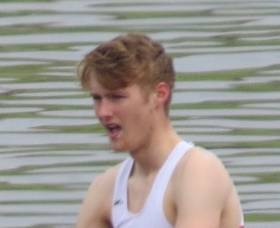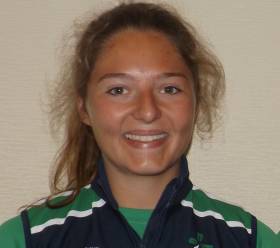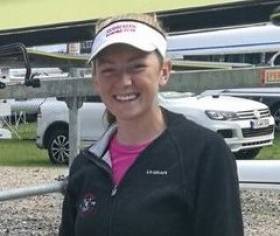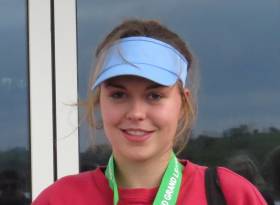Displaying items by tag: Ireland
Ireland Rowers Contend in A Finals at Coupe de la Jeunesse
#Rowing: Ireland had two boats which finished just outside the medal placings on the final day of the Coupe de la Jeunesse in Corgeno, Italy, today. The junior women’s and junior men’s quadruples both finished fourth. The women's crew of Sadhbh Scully, Aoife Lynch, Anna Tyther and Lucy McCoy were 1.34 behind the Czech Republic in a race won by Italy, with Spain second. As they had been on the Saturday, the men’s quadruple of Rory O’Neill, Thomas Kelly, Fionn O’Reilly and Andrew Sheehan were again held out of the final medal position by Britain.
Coupe de la Jeunesse, Corgeno, Italy, Day Two, Sunday (Irish interest)
Men
Junior Quadruple – A Final: 4 Ireland 6:17.33
Women
Junior Four – B Final: 1 Ireland 7:24.53
Junior Pair – B Final: 1 Ireland 8:05.15
Junior Quadruple – A Final: 4 Ireland 7:01.60
Junior Double – B Final: 6 Ireland 7:55.41.
#Rowing: The Ireland junior men’s quadruple finished just outside the medals at the Coupe de la Jeunesse in Corgeno, Italy, today. The crew of Rory O’Neill, Thomas Kelly, Fionn O’Reilly and Andrew Sheehan were just .87 off a medal. Italy won from Spain, with Britain just ahead of Ireland in bronze medal spot.
Ireland had two other A Finalists: the junior double of Chris Kirwan and Holly Davis finished fifth. The new unit had finished a good second in their heat, and were in the leading three in their race until the final quarter. The junior women’s pair of Claragh O’Sullivan and Jane Duggan also took fifth.
The junior women’s quad and four took second in their B Finals.
Sunday gives all the crews another chance to compete in heats and finals.
Coupe de la Jeunesse, Corgeno, Italy (Irish interest)
Men
Junior Quadruple – A Final: 4 Ireland 6:21.12.
Women
Junior Four – B Final: 2 Ireland 7:39.41.
Junior Pair – A Final: 5 Ireland 8:26.52.
Junior Quadruple – B Final: 2 Ireland 7:23.26.
Junior Double – A Final: 5 Ireland 8:09.44
Ireland Eight Open Coupe Campaign
#Rowing: Ireland’s junior women’s eight finished seventh in the first race of the Coupe de la Jeunesse in Corgeno, Italy. The race was won by Spain, with the Netherlands second and Britain third. Eight crews competed.
The Coupe has two full days of action on Saturday and Sunday.
#Rowing: Ireland took a silver medal at the World Rowing Under-23 Championships today through the women’s four of Claire Feerick, Eimear Lambe, Tara Hanlon and Emily Hegarty, who swapped into the stroke seat for Lambe.
Britain and Ireland swept into the lead early and were clear of the rest in the final quarter. Britain found just enough to beat Ireland by 1.46 seconds.
World Rowing Under-23 Championships, Sarasota Bradenton, Florida (Irish interest)
Women
Four – A Final: 1 Britain 6:34.22, 2 Ireland (C Feerick, E Lambe, T Hanlon, E Hegarty) 6:35.68, 3 United States 6:39.89.
Ireland Take Bronze Medal at World Under-23 Championships
#Rowing: The Ireland lightweight men’s quadruple of Eoin Gaffney, Hugh Sutton, Ryan Ballantine and Miles Taylor took a bronze medal today at the World Under-23 Championships in Sarasota Bradenton in Florida.
Italy made a tremendous start. They pushed clear of the other five crews and led all the way to the finish line. France and Ireland slugged it out behind them, with the French closing on Italy coming to the line. Ireland also finished fast, but while they overlapped France they could not catch them.
World Rowing Under-23 Championships, Sarasota Bradenton, Florida (Irish interest)
Men
Four, coxed – B Final (places 7 and 8): 1 Ireland (B O’Rourke, R Corrigan, D Lynch, J Quinlan; cox: E Finnegan) 6:18.43, 2 Germany 6:22.17.
Lightweight Quadruple Sculls – A Final: 1 Italy 5:59.12, 2 France 6:00.20, 3 Ireland (E Gaffney, H Sutton, R Ballantine, M Taylor) 6:01.98.
Ireland Keep Germany at Bay at World Under-23 Championships
#Rowing: The Ireland men’s coxed four won their B Final and finished seventh overall at the World Under-23 Championships in Sarasota Bradenton in Florida today.
Germany were the sole other contenders in this race. Ireland’s Brion O’Rourke, Ross Corrigan, Daire Lynch, James Quinlan and cox Eoin Finnegan got ahead of them early and did not yield.
They extended their advantage to just over a length and held it to the finish line.
World Rowing Under-23 Championships, Sarasota Bradenton, Florida (Irish interest)
Men
Four, coxed – B Final (places 7 and 8): 1 Ireland (B O’Rourke, R Corrigan, D Lynch, J Quinlan; cox: E Finnegan) 6:18.43, 2 Germany 6:22.17.
Four Wins for Ireland at Home International Regatta UPDATE
#Rowing: The Ireland junior men’s eight topped off a series of four Ireland wins – all at junior level – at the Home International Regatta in Strathclyde Park in Scotland. They beat Scotland by just over two seconds, while England came in one second further back.
Thomas Hume and Sam Reidy, both from Coláiste Íognáid, were winning their second gold. They had been the best junior men’s pair – coming home more than 20 seconds faster than Scotland, who were second.
Holly Davis (14) also had a big win on her debut at international level. The Lee Valley girl had almost 12 seconds to spare over second-placed Ellie Cushen of England in the junior women’s single sculls race.
The junior men’s quadruple also pushed England into second in their race – but by a finer margin. The crew of Dara Kelly (Lee), Tiarnan McKnight (Three Castles) and Colum Brennan and Ronán Brennan of Neptune won by 1.21 seconds from England.
Home International Regatta – Strathclyde Park, Scotland: Final Standings:
Men – Senior: 1 Scotland 33 pts; 3 Ireland 22. Jun: 1 Scotland 21; 3 Ireland 19.
Women – Sen: 1 Scotland 33; 4 Ireland 13. Jun: 1 England 26; 2= Ireland, Scotland 17.
#Rowing: The lightweight double of Aoife Casey and Cliodhna Nolan became the third Ireland boat to qualify for an A Final at the World Under-23 Championships today.
They won their repechage. Two boats would go to the A Final, and Ireland took over the lead after 1,000 metres and refused to yield despite strong charges by Britain and the Netherlands. The Dutch landed the valuable second spot.
World Rowing Under-23 Championships (Irish interest)
Women
Lightweight Double Sculls – Repechage (First Two to A Final; rest to B Final): 1 Ireland (A Casey, C Nolan) 6:54.54, 2 Netherlands 6:54.76; 3 Britain (1 F Chestnutt) 6:55.86.
#Rowing: The Ireland women’s four qualified for the A Final at the World Rowing Under-23 Championships in Florida. The crew of Claire Feerick, Emily Hegarty, Tara Hanlon and Eimear Lambe won their repechage – by far the fastest of two – by leading all down the course.
The lightweight men’s quadruple also won their preliminary race for lanes. They were ahead through all the four quadrants of the race and won by a length from France.
The men’s coxed four finished fifth in their repechage. They lost out on the fourth and final qualifying place in the A Final by .49 of a second. Britain and New Zealand passed early leaders South Africa to take first and second, with the South Africans taking third.
Aoife Casey and Cliodhna Nolan had finished fourth in their heat of the lightweight double sculls.
World Rowing Under-23 Championships, Sarasota Bradenton, United States (Irish interest)
Men
Four, coxed – Repechage (First Four to A Final; rest to B Final): 1 Britain 6:12.79, 2 New Zealand 6:13.53, 3 South Africa 6:14.32, 4 United States 6:15.07; 5 Ireland (B O’Rourke, R Corrigan, D Lynch, J Quinlan; cox: E Finnegan) 6:15.56.
Lightweight Quadruple – Preliminary Race: 1 Ireland (E Gaffney, H Sutton, R Ballantine, M Taylor) 6:02.20
Women
Four – Repechage (First Two to A Final; rest to B Final): 1 Ireland (C Feerick, E Hegarty, T Hanlon, E Lambe) 6:37.88, 2 China 6:41.23.
Lightweight Double Sculls – Heat One (First two to A Final; rest to Repechage) 1 Switzerland 6:59.78, 2 Germany 7:02.65; 4 Ireland (A Casey, C Nolan) 7:07.28, 5 Britain (1 F Chestnutt) 7:13.48.
Third Spot in Fast Heat for Ireland Four in Florida
#Rowing: Ireland took third place in a fast heat of the women’s four at the World Rowing Under-23 Championships in Sarasota-Bradenton in Florida.
The winner alone went directly through to the A Final. The United States claimed this spot, with Britain and Ireland closing fast coming to the line. This was much the faster of the two heats.
The Ireland crew of Claire Feerick, Emily Hegarty, Tara Hanlon and Eimear Lambe would hope to qualify through their repechage on Thursday.
World Rowing Under-23 Championships, Sarasota-Bradenton, United States (Irish interest)
Men
Four, coxed – Heat Two (Winner to A Final; rest to Repechages): 1 Australia 6:11.99; 4 Ireland (B O’Rourke, R Corrigan, D Lynch, J Quinlan; cox: E Finnegan) 6:18.79.
Women
Four – Heat One (Winner to A Final; rest to Repechages): 1 United States 6:32.15; 2 Britain 6:32.96, 3 Ireland (C Feerick, E Hegarty, T Hanlon, E Lambe) 6:33.10.































































